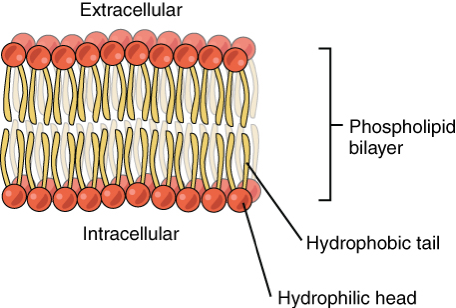Lecture 8 Membrane Structure BIOMG 1350
1/43
There's no tags or description
Looks like no tags are added yet.
Name | Mastery | Learn | Test | Matching | Spaced |
|---|
No study sessions yet.
44 Terms
What is the main function of membranes?
They act as selectively permeable barriers.
Do eukaryotes and prokaryotes both have internal membranes?
No; eukaryotes have internal membranes to control organelle composition; prokaryotes’ only membrane is the plasma membrane.
What types of molecules can pass through membranes easily?
Small nonpolar/hydrophobic molecules (e.g. O2, CO2, N2).
How well do small uncharged polar molecules move across membranes?
They struggle to pass through (e.g. water).
Can larger uncharged polar molecules pass through membranes?
No, because of their size and polarity.
Can ions pass through membranes?
No; ions have a strong attraction to water and strong repulsion from the hydrophobic membrane interior.
What roles does the plasma membrane serve besides being a barrier?
It’s the interface the cell has with the environment. It’s responsible for selective transport, communication, structural support, cell recognition, compartmentalization, signal transduction, permits cell division without rupture, etc.
What surrounds the plasma membrane?
Water. Inside and out.
What is the structure of the plasma membrane’s surface and core?
Phospholipid bilayer with a hydrophilic surface (phosphate groups/heads) and hydrophobic core (fatty acid tails) inside.

What does amphipathic mean in membrane lipids?
Part hydrophilic, part hydrophobic.
What is the general structure of phospholipids?
Hydrophilic phosphate head;
Glycerol molecule;
Two hydrophobic fatty acid tails.
What is the most abundant type of lipid in membranes?
Phospholipids.
What causes a kink/bend in one fatty acid tail?
A double bond (unsaturated).
How are phospholipid components linked?
Fatty acid tails linked to glycerol; glycerol linked to polar head group.
Do all phospholipids have the same head groups?
No. Different head groups mean different properties, meaning different functions (e.g. phosphatidyl-serine vs. phosphatidyl-choline).
Why does the hydrophilic head face water?
It is energetically favorable. Hydrophilic means water-loving.
How are membranes structured?
As bilayers made of 2 monolayers (leaflets) of phospholipids.
Why do bilayers spontaneously form sealed compartments?
Because exposed edges in water are energetically unfavorable; sealed bilayers are favorable.
Where is water relative to the plasma membrane?
Both inside and outside the membrane.
How do phospholipids move within the membrane?
Flexion
What type of lipid movement rarely happens without help?
Flip-flop (swapping between leaflets).
What does membrane fluidity mean?
The lateral movement of lipids in the bilayer.
Which membranes are less fluid: saturated or unsaturated?
Saturated lipid membranes are less fluid.
What happens when membranes freeze?
Lipids stop moving.
What is the structural difference between saturated and unsaturated lipids?
Unsaturated = double bonds
Which force helps pack lipids together?
Van der Waals interactions.
What factors affect fluidity?
Temperature
How does cholesterol alter membrane fluidity?
Inserts between phospholipids to reduce fluidity or increase fluidity at low temperatures.
Why do short fatty acid tails increase fluidity?
They have weaker van der Waals interactions.
Is the plasma membrane lipid bilayer symmetric or asymmetric?
Asymmetric.
Where are most phospholipids made?
In the ER (some in mitochondria).
What protein randomizes phospholipids in the ER membrane?
Scramblase.
What protein in the Golgi selectively flips phospholipids to create asymmetry?
Flippase.
By mass
what is the composition of membranes?
What are the main functions of membrane proteins?
Transporters
What are the two categories of membrane proteins?
Integral and peripheral.
What are the types of integral proteins?
Transmembrane
How do peripheral proteins interact with membranes?
Bind to integral proteins or membrane surfaces.
What structure do proteins often use to cross bilayers?
Alpha helix with hydrophobic side chains outward.
How is a hydrophilic pore formed in membranes?
Multiple transmembrane alpha helices with hydrophilic interiors.
How can protein diffusion in membranes be measured?
Fluorescence Recovery After Photobleaching (FRAP).
How does FRAP work?
Proteins are GFP-tagged → laser bleaches part of membrane → unbleached proteins diffuse into the area → recovery rate measured.
What does a slower recovery in FRAP mean?
Lower mobility of proteins.
What can restrict the lateral mobility of membrane proteins?
Binding to cortex proteins